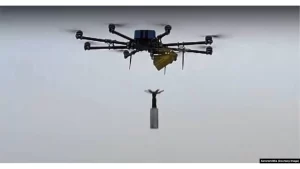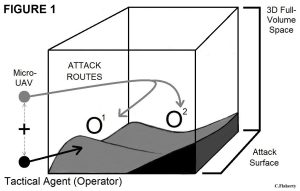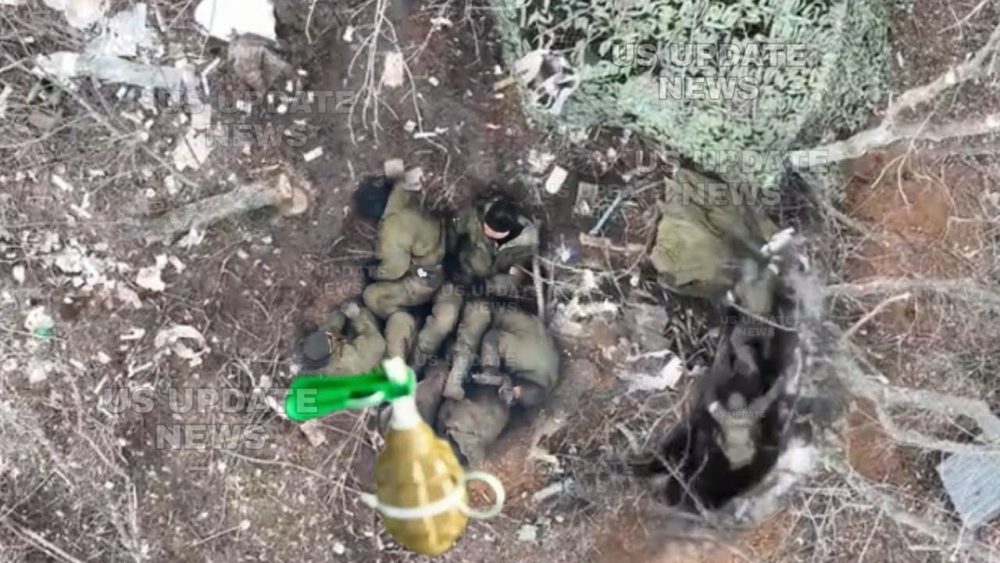
![]()
Intelligence Research Observatory
Cover Image Courtesy of US Update News Via YouTube Screenshot & Radio Free Europe


An Analysis Authored by Esteemed Colleague Dr. C. Flaherty Independent Space Industry Analyst
Dr. Flaherty can be found on Twitter @ChrisFlaherty8
Bilocation Tactics-The Next Warfighting Revolution
INTRODUCTION
Bilocation is a concept taken from metaphysics and religion where an object or person is located (or appears to be located) in two distinct places at the same time. This introductory discussion paper will look at Technological Bilocation brought about through the use of drones on the battlefield, and beginning of the next warfighting revolution where a Tactical Agent can physically operate in two locations simultaneously, with the aid of a Drone Avatar (weapons platform drone).

The next warfighting revolution will be one, where not only is the Drone Avatar an active Tactical Agent, but the Human operator is one as well; and both active Tactical Agents (Human and Drone) operate simultaneously against the same or several targets under the control of the same mind. Comparatively, in a ‘normal’ tactical scenario there are several Tactical Agents teamed, they are coordinated, and each perform a tactical task. In a bilocation scenario, the Tactical Agent and their Drone Avatar are able to view, decide, manoeuvre, and fire at the same or several targets, operating as a bilocated entity.
The next tactical revolution will occur with individual adaptation to drone ISR: Intelligence, Surveillance, Target Acquisition, and Reconnaissance, and making use of a Drone Avatar (weapons platform drone). The adaptation will allow a Human Tactical Agent to operate simultaneously with their Drone Avatar against a target, or several targets. The second portion of the next tactical revolution will be rewiring Human brains from 2D to 3D tactical thinking to allow two (or more) tactical scenarios to be envisaged, and simultaneously operationalized against the same or multiple targets.
THE 2D SEE TARGET PARADIGM
At an evolutionary level Humans and their hunting (that evolved into) tactical thinking, have largely developed 2D warfighting skills. As apex hunters biologically, for the last 4.2 million years, our upright position, and forward positioned eyes have had a fundamental bearing on how we tactically operate, and our perception of the field of fire in relation to targets. From early development Humans experientially develop operating as 2D entities in volume space.
The notion that a target can be viewed from more than one position is biologically and conceptually impossible, as we only see in the direction our eyes are facing. Technologically, however, this enduring feature of the 2D See Target Paradigm can be fundamentally altered into a new configuration where Human eyes view (from their position), at the same time viewing through digital display on glasses-goggles an alternative view from a drone camera. Conventionally, that relationship is essentially linear and sequential, and filters-out the Human eye view, to just the Drone Camera Eye, as a mere extension of the Human Eye:
Drone mobility can shift around the basic linear and sequential relationship to seeing a Target from two positions in space simultaneously
Human brain working also changes, as it is now processing simultaneously a target from two different positions in space: two tactics (TACTIC 1 and TACTIC 2) at the same time, potentially against the same target. In a ‘normal’ tactical scenario this is performed by two or more Tactical Agents acting in a coordinated attack. In the Bilocation Scenario this is now performed by the same Tactical Agent who is physically located in two places at the same time (the Drone Avatar being the ‘other’). Research questions arising from the Bilocation Scenario, are:
(1) How effectively can a Human brain conceptualise two completely alternative tactics, in two physically separated locations, as two physically different entities; and,
(2) How does decision and feedback (the classical OODA Loop) operate as a Human brain is processing both the feed from the Human Eye(s) and Drone Camera Eye simultaneously, as this feeds into the tactical thinking process.
TECHNOLOGICAL BILOCATION AND DRONE AVATAR DEVELOPMENT

FIGURE 1: Development of a Drone Avatar is the first step in the emergence of a new branch of tactics undertaken by a bilocated entity: that is an entity located in two distinct places at the same time acting against a target (or possibly several targets) simultaneously along different attack vectors, and employing different tactical approaches. In ‘normal’ tactics, even where the Human operator is physically separated from the weapon they are employing – commonly seen in drone, and Space warfare, there is a distinct linear connection/sequence at play between the operator, and drone (weapon) they are operating. Where there are more than one drone-operator combination there is combined action to achieve overwhelm of the target(s).
FIGURE 2: Looks at a scenario – building on the notion of combined arms, where the Tactical Agent (Operator) is also a combatant attacking from one vector, while simultaneously controlling another, or more Drone Avatar(s) in separate simultaneous attacks against the target(s). It is also possible to utilize flying ISR Drone(s) digitally connected to Tactical Agent (Operator) that gives a full 3D view of battle. This would enable better attack coordination between the Tactical Agent (Operator) and their Drone Avatar(s) against their target(s).

REFERENCES
- Flaherty, C. 2018 Micro-UAV Augmented 3D Tactics. Small Wars Jcom
- Flaherty, C. 2010 Command, Influence and Information in 3D Tactics. Journal of Information Warfare. Volume 9. Issue 1.
- Flaherty, C. 2009 Interposing Tactics. Red Team Journal.com
- Flaherty, C. 2009 A New Approach to Mass Space. Red Team Journal.com
- Flaherty, C. 2009 2D Verses 3D Tactical Supremacy in Urban Operations. Journal of Information Warfare. Volume 8. Issue 2.
- Flaherty, C. 2009 2D Verses 3D Tactical Supremacy in Urban Operations. 4th International Conference on Information Warfare and Security. Cape Town, South Africa, 26-27 March. Proceedings of ICIW.
- Green, A. Piper, I. Keep, D. Flaherty, C. 2009 Simulations in 3D Tactics, Interdiction and Multi-Agent Modelling. SimTecT: Simulation Conference: Simulation – Concepts, Capability and Technology (Adelaide, 15-18 June).
- Flaherty, C. 2008 3D Tactics and Information Deception. 7th European Conference on Information Warfare and Security (UK University of Plymouth, UK, 30 June–1 July).
- Flaherty, C. 2008 3D Tactics and Information Deception. Journal of Information Warfare. Volume 7. Issue 2.
- Flaherty, C. Green, A.R. 2008 3D Tactics, Interdiction and Multiagent Modelling. International Crime Science Conference. University College London, Centre for Security and Crime Science (17-18 July).
- Flaherty, C. 2008 3-D and GIS Based Vulnerability Analysis in Australia. 6th Annual National Security Australia Conference.
- Flaherty, C. 2007 3D Tactics: An Advanced Warfare Concept in Critical Infrastructure Protection, International Journal of Emergency Management. Volume 4. Issue 1.
- Flaherty, C. 2007 Mass Space Vulnerabilities Analysis in 3-D Tactics, International Crime Science Conference. University College London, Centre for Security and Crime Science (16-17 July).
Flaherty, C.J. 2006 3D Tactics: An Advanced Warfare Concept in CIP. Balducelli, C. Bologna, S. (Editors) Proceedings –CNIP’06 Workshop on Complex Network & Infrastructure Protection (Rome 28-29 March). ENEA – Italian National Agency for New Technologies, Energ






